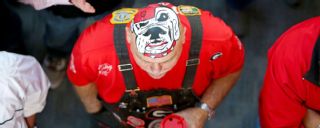|
They're all chasing Giles Pellerin whether they know it or not. For those fans who go all out to go to every game -- the superfans -- Pellerin's streak of attending 797 consecutive football games could be the mountaintop if those superfans weren't just having such an amazing ride following their teams. When the Trojans opened the 1926 season against Whittier, Pellerin, a USC student, was in the stands. USC wouldn't play another game without Pellerin watching for 72 years. They've rescheduled weddings (and funerals), they've driven, flown, caught trains and hitched rides. They've crossed millions of miles, seen championships and losing seasons, seen life and death, all without missing a game. You can call it crazy or, as the superfans do, call it devotion to something meaningful in their lives.  "I don't think I'm a nut. It's all been fun," Pellerin once said. "Sure, I could sit in my rocking chair and grow old ... You've got to have something to look forward to." Here are the stories of some of college football's superfans: Humble, and not so humble beginningsWhat they're all looking forward to is the next game. But simply going to games can't be everything, right? Why spend the money? Why go through the hassle for years? Edith Isacke bought her first season tickets in 1956. She's 92 now, still attends every home game, and is one of Penn State's longest-tenured season-ticket holders. "I just enjoyed going, and it was something I always loved to do," Isacke said. "I didn't miss many games in the last 25 years. When my son was getting married, it was an Alabama game, and we told him to just have the wedding a little later in the day, but he didn't. So we all watched the Alabama game before his wedding. "My daughter was pregnant and I told her, jokingly, not to have her baby on the day of a football game, and sure enough, she had the baby on the day Penn State played Nebraska one year." Roy Nwaisser, better known as "USC Psycho," started almost as quietly as Isacke. He decided to go to USC's 1992 game at Stanford. Twenty-five years and 321 consecutive games later, Nwaisser still hasn't missed a game.  Nwaisser is frequently shown on television broadcasts holding a personalized California license plate that reads "USC SYCO," and some people call him the modern-day Giles. He is often asked if he is chasing Pellerin's legendary streak, but when he hears that question, his initial reaction is to laugh. "I think it's silly. I'm still, after 25 years, nowhere near his streak, and I just can't wrap my head around how I could continue doing this for as long as he did," Nwaisser said. "But, of course, if you had asked me 25 years ago if I would be able to do this for 25 years, I would have told you you were crazy. So who knows? Maybe I will do it for another 50 years, but it just seems so crazy. "I don't have any plans to stop, but I can't fathom there wouldn't be something to keep me from a game for some reason between now and the next 50 years." Nothing stands in the way of the streakIn her 90s and living in a retirement community, Isacke has one of her children drive her from her home in Gaithersburg, Maryland, to each Penn State home game. That's an easy one. Traveling thousands of miles over multiple decades through every part of the country without missing a single game requires a little luck. Maybe more than luck. Fate, or even, divine intervention. In 1989, Hurricane Hugo made landfall in Charleston, South Carolina, after hitting the U.S. Virgin Islands and Puerto Rico. The storm was heading to South Carolina as Maryland was preparing for a road game at Clemson. 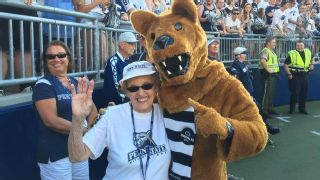 Bob Baker hasn't missed a Maryland football game since 1976. Nwaisser might draw comparisons to Pellerin for their USC ties, but Baker has a more than 170-game lead on Nwaisser for consecutive games attended. And you might think a storm that caused $10 billion in damage might deter someone from traveling to the South Carolina area. But most people aren't superfans. When Baker's flight to Greenville-Spartanburg Airport was canceled, he opted to instead fly to Atlanta and drive the 125 miles from Atlanta to Clemson. That's nothing for Nwaisser, who will always remember Sept. 8, 1994. The Trojans were playing at Penn State on Sept. 10, and Nwaisser booked a flight through Chicago to Pittsburgh the Thursday before the game. That flight was USAir Flight 427. At 7:03 p.m. on Sept. 8, that aircraft crashed into a runway at Pittsburgh International Airport and exploded. All 132 people on board were killed. Nwaisser was not one of them. He was able to get a cheaper flight that arrived earlier in the day. He was eating at a restaurant near the airport when the plane crashed. "That's one of the sickest feelings I've ever had in my stomach," he said, "when I realized what happened. "All of a sudden there was one ambulance after another, firetrucks, it was a never-ending stream of emergency vehicles. ... We had no idea what was going on, and then I found out the plane had crashed and [I] ran to a pay phone to call my parents and tell them I'm alive and OK." Pellerin, the godfather of superfans, even had his close calls. In October 1949, Pellerin suffered a ruptured appendix, and an emergency appendectomy looked like it would end Pellerin's streak 23 years after it began. Neither the surgery nor the hospital staff, however, could keep Pellerin away. He just told nurses he was going for a walk, made it to the Coliseum in time to see USC beat Oregon and was back in his hospital bed that night. Twice after that, Pellerin managed a medical crisis without missing a game. Following a surgery to remove a stomach tumor in 1969, Pellerin was supposed to stay bedridden for six weeks, but that didn't work for him. A couple of weeks later, he was back in his seat when the season began. In 1993, he suffered a ruptured aortic abdominal aneurysm while traveling to see the Trojans play at Penn State and required a 12-day hospital stay in Pennsylvania. The streak lived on, however, because USC had a bye the following week, giving him just enough time to make it back for the next game. "God must be a Trojan," Pellerin once said. "I've been lucky." Of life, death and the streakThese streaks and their fans are really about stubborn desire. And time. Years go by, teams win and lose, and the people on and around the streak come and go. Tom Ables was perhaps the only fan who got closest to Pellerin's mark. In 72 seasons of following San Diego State football, he missed six of 794 games. Six! He died in October, just short of attending his 789th San Diego State game. 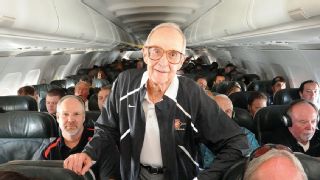 Pellerin, himself, literally died at his 797th consecutive game. He suffered cardiac arrest in the Rose Bowl parking lot with USC in the midst of a seven-game losing streak to UCLA. For the Woods family, deaths have been a big part of their superfandom. They love Georgia. So much so that three generations of Woods men have intricately painted Bulldogs on their bald heads. Just like grandpa taught them. Lonnie Woods came home from World War II and got a job as a driver for the UGA transit system. He would eventually drive one of the Bulldogs' team buses. At the time Woods was driving the bus, Erk Russell was the defensive coordinator for Georgia, and was well known for head-butting his players with their helmets on, causing blood to stream down his forehead. "My grandfather tried to get Erk Russell to paint the bulldog on his head, but he couldn't because he worked for the university," said Trent Woods, Lonnie's grandson. "... My grandfather thought what better than the bulldog with blood coming out of his mouth. But Erk told my grandfather he ought to do it, so that's how it all started." Lonnie Woods took Russell up on the offer, and in 1980 at the Sugar Bowl, with Georgia playing Notre Dame, Woods found an art student to paint a bulldog on his bald head. The Bulldogs won the national championship that night and a family tradition was born. Woods painted his head for the next six years before dying of a heart attack in 1986. 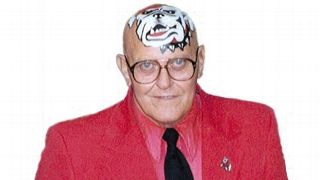 When his father died, Mike Woods was hesitant to carry on his family legacy of painting bulldogs on bald heads. It wasn't until 1995 that Mike first painted his head. "So after that, people would come up to him and say, 'I got my picture with your father,' and they would ask him for a picture," Trent said. "Dad always looked up to grandpa, so I think that was one of the things that helped dad and grandpa bond together, was Georgia football, and we partly owe Georgia to having the relationship we had with our fathers." For other superfans, life's big moments, both good and bad, have come in close contact with their fandom. Baker, the Maryland fan, has found a way to make it to every Terrapins game for 41 years, even as it meant rescheduling a wedding and a funeral. "My brother got married in 1980, so this was around 1979, and he told me he'd like me to be his best man," Baker said. "So I asked him when the wedding was, and he told me whatever the date was, and it was the date of the Penn State game. I told him, 'You know what, I'm not going to be able to be the best man because I have to go to this football game.' "I realize now that was probably the wrong thing, but he and my sister-in-law took it in stride and rescheduled their wedding to June. Looking back on it, I kind of regret that because it was their wedding day, but they still had a nice day." And when his wife's grandfather died early on the Monday before a Wake Forest game, Baker suddenly needed a memorial service rearranged. "All I could think of is, 'This is going to screw this game up,'" Baker said. "It was one those things where I thought maybe the funeral would be on a Friday, so I said to [my wife], 'Ask your mom if she can use her influence to have the funeral scheduled on Sunday.' I had never heard of a funeral on Sunday, but my wife asked if we could have the funeral Sunday, and we did." Moving a funeral wasn't a problem for Nwaisser. This season he has held two memorial services at his USC tailgate, known as "Psychogate." For the past 15 years, Psychogate has been the self-proclaimed "longest-running, biggest and best fan-run tailgate on the USC campus" prior to home games. It's primarily USC fans in attendance, but Nwaisser encourages visiting fans to stop by, too. On a visit to Auburn in 2003, he was blown away by the hospitality shown by Tigers fans and has modeled his own tailgate after his experience there. Psychogate was co-founded by Rumy Lopez, who died of cancer in the offseason, but was a longtime road-game travel partner to Nwaisser. Before USC hosted Stanford on Sept. 9, Psychogate brought together several groups of people who had known Lopez over the years and served as a memorial service in his honor. Lopez's ashes were present, photos of him were on display, his friends reminisced and, finally, somberly listened to a bagpiper perform in his honor. The bagpipes player returned for the memorial of another longtime Trojans fan before USC played UCLA on Saturday. Some of Nwaisser's best USC memories took place on the road with Lopez. At a bar in Tallahassee, Florida, in 1998, Nwaisser and Lopez -- in a peace offering to Florida State fans -- bought a round of drinks for the entire bar. Unsurprisingly, the gesture won over the Seminoles fans. The two were together in the stands at Notre Dame Stadium in 2005, where, for a while, it seemed like USC's pursuit of perfection was going to end. Then, of course, Reggie Bush pushed Matt Leinart into the end zone and all was well. "I remember Rumy calling us together, huddling us around, and he said a little prayer for us and we just sat there with our hearts pounding and our guts in our throats," Nwaisser said, recalling USC's 34-31 victory. "We sat there the rest of the game, and when we pulled it off, it was the most euphoric experience I've ever had in my life. It was unbelievable." After the bagpipes at Lopez's impromptu pregame funeral, the tailgate went on, ahead of another game in the streak, as Lopez would have wanted. 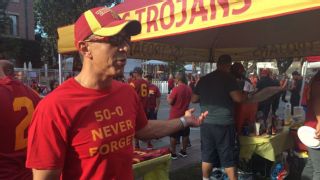 And that's the thing with the superfans. Their streaks and teams and games aren't taking away from their lives. Even if they miss a wedding here or there. It is their lives. It has connected them to friends, a team and a community. It's their legacy. When Mike Woods died after 22 years of painting bulldogs on his head, his son faced the same question he had. Could he carry on with this unique tradition? "Truthfully, this is my way of grieving. I kind of closed up when Dad died, and my grieving was halted when he passed because I needed to take care of my family," Trent Woods said. "Some of my friends asked me right after [his father died], are you going to start painting your head right now? I said, 'No, I can't do it right now.' My grandfather started doing it for football season, my dad started during football season, and I'll start in football season." When Georgia's spring game came around, Trent had his mother paint a bulldog on his head with a blank face. The interior of the face read, "To Be Continued, 9-2-2017," the date of the first game of the season.  That first game of the 2017 season, against Appalachian State, Trent Woods and his mother sat at their tailgate while his mother painted the bulldog on his head. Rather than just showing up with it already painted, Trent believed this was the best way to continue the tradition and allow his father to pass it on to him. "When Dad had people coming up to him, showing him pictures of Grandpa, now I have people coming up to me saying, 'I have a picture with your dad, I'd like a picture with you,'" Trent said. "To get to be a part of that was something. It's hard to put into words because I got to spend time with my father and have fun with him. To see how much he cheered people up around him with his head painted, to get to carry that on is a blessing."
|


